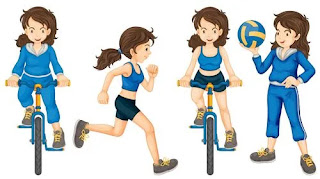What is Physical Exercise or Body Workout?
Physical Exercise or Body Workout
Definition of Exercise: Exercise is defined as a physical
activity that utilizes planned, structured, and repetitive physical activity to
improve the health of one or more body parts. Be strong and cultivate virtues
such as bravery, resourcefulness, and safeguarding the collective good.
Meaning of Exercise: Exercise also means workout i.e. an
activity Interpretation to improve work ability through production labor. Most people exercise in premises called gym. People form physical and mental fitness network or groups for proper information and sharing fitness images of themselves for proper motivation. It refers to forging or smelting source.
|
Table of Content |
|
1. Health
science terms ▪
Exercise time ▪ Winter
and summer fitness ▪
Scientific fitness 2. Notes |
Basic explanation: The original meaning of exercise is to
strike and forge the sword, and it is extended to improve consciousness and
work ability through productive labor, social struggle and work practice.
Q. Explain ‘Exercise’ in detail
Ans. Exercise refers to forging or smelting. It refers to strengthen
the body through physical activity, and cultivate virtues such as bravery,
alertness, and safeguarding the collective good.
This is brought through productive labor, social struggle and
work practice, consciousness and work ability can be improved.
It also refers to movement or long workout.
What is smelting and forging?
1. Smelting and forging "Human iron and stone are
natural, and those who are still forging chains will change their qualities.
If people have the nature of the five constants, the sages
have not yet mastered the forging ears, so what is the bad nature of suffering?
If take the iron home and exercise it day and night. It
took three whole years of spirit to forge two swords.
2. Smelting and forging refers to making the body strong
through sports. As long as students are psychologically able to fully
understand the purpose of sports, it is to exercise their own bodies, not to
win competitions, but to make them do it properly.
Health Science Terminology
Which is the best Exercise Time?
The study found that high-intensity exercise can be carried
out two hours after meals. Moderate exercise should be arranged one hour after
meals.
Light exercise is most reasonable half an hour after meals.
According to this, several optimal exercise time periods can be derived:
Morning time: Morning until before breakfast
Morning session: 2 hours after breakfast to before lunch
Afternoon session: 2 hours after lunch to before dinner
Evening hours: 2 hours after dinner to bedtime
There are pros and cons to exercise in each of the above
periods.
For example, in the morning period, if the exercise intensity
is not properly controlled, it is easy to cause hypoglycemia.
However, exercising in the morning and afternoon is
influenced by objective factors such as work, work and housework.
Modern exercise physiology studies have shown that the
highest and lowest points of human physical strength are controlled by the
body's "biological clock", which generally peaks in the evening.
For example, the metabolic rate of the human body will reach
its peak between 4:00 pm and 5:00 pm, and the flexibility and flexibility of
the body will also reach the best state.
The regulation of heart beat and blood pressure is most
balanced between 5:00 pm and 6:00 pm , and the body's sense of smell, touch,
vision, etc. are also the most sensitive between 5:00 and 7:00 pm. Therefore,
on the whole, the effect of exercise in the evening is better.
In addition, the activity of hormones in the human body is
also in a good state between 4:00 and 7:00 in the afternoon, and the body's
adaptability and nerve sensitivity are also the best. Therefore, experts
advocate exercise in the evening, but in the evening, pay attention to the
intensity of exercise, otherwise too high intensity will excite the sympathetic
nerves and prevent falling asleep.
Which is the best time of day to exercise?
Afternoon: (14:00-16:00): It is a good time to strengthen
physical strength, and the muscle endurance is 50% higher than other times.
Dusk: (17:00-19:00): Especially when the sun sets, the human
body's exercise capacity reaches its peak, and the senses such as vision and
hearing are more sensitive, and the heart rate and blood pressure also rise.
What time not to exercise?
After meals: At this time, more blood flows to the stomach to
help food digestion and absorption. At this time, exercise will hinder the
digestion of food, which will lead to diseases of the gastrointestinal system
and affect the health of the body for a long time. Therefore, it is best to sit
or lie down for 30 to 45 minutes after meals and exercise.
After drinking: Alcohol is absorbed into the blood and enters the brain, heart, liver and other organs.
Exercise at this time will increase
the burden on these organs. Compared with exercise after meals, exercise after
drinking has a greater negative impact on the human body.
Health reminder: Outdoor fitness is not the sooner the better
In the cold winter, many people choose to exercise in the
morning to enhance their immunity.
Is outdoor fitness the sooner the better?
Relevant
health experts suggest that outdoor fitness in winter is suitable for after
sunrise.
It is understood that the ground temperature before sunrise
in winter is lower, and the content of pollutants such as carbon monoxide and
carbon dioxide released in the early morning air is higher.
In addition, nitrogen oxides, hydrocarbons, lead and other
harmful pollutants in the exhaust gas of automobiles also gather on the ground.
If people get up early to exercise, they will inhale a lot of smoke and toxic gases.
Exercising in this environment for a long time may cause
fatigue, dizziness, pharyngitis and other diseases, endangering your health.
Winter Fitness and Summer Fitness
Winter fitness should be around 10 o'clock. At this time, the
sun comes out and basks on the ground, so that the atmosphere begins to convect
up and down, and the polluted air spreads to the high altitude, which will
reduce the damage to the human body.
In addition, the morning temperature in winter is low, and it
will not slowly ease until half an hour after the sun comes out
In the first month or two of winter and spring, you should
avoid the peak of air pollution at six or seven in the morning.
In summer and autumn, the sun comes out early, and you can
exercise at five or six o'clock.
In normal times, you can choose between 10 am and 3 or 4 pm
to do recess exercises or other sports. At this time, the air is cleaner, which
is more beneficial to health.
It's best not to exercise outdoors on a foggy morning. Due to
air pollution, fog contains many substances that are harmful to human body.
When people do strenuous activities such as long-distance
running in the fog, some sensitive parts of the body are exposed to these
harmful substances and inhaled in large quantities, which may cause bronchitis,
laryngitis, conjunctivitis and allergic diseases.
So on a foggy morning, we can change our morning exercise
indoors instead of going outdoors.
What is scientific fitness?
Some people are accustomed to exercising on an empty stomach
in the morning, and some people advocate physical exercise after dinner.
When is the best time to exercise?
We think it is appropriate
to start exercising half an hour or an hour after breakfast or dinner.
Exercising before meals may cause blood sugar fluctuations.
It may be hypoglycemic due to delayed meals, or it may be hyperglycemic due to
no medication.
Of course, it may be that blood sugar is first low and then
high due to the Su Mujie reaction, so it is best to Put exercise time after
meals.
In order to avoid the impact on the function of the digestive
system, it is best to do physical exercise more than half an hour after the end
of the meal.
Physical exercise after dinner is worth advocating, because
most people eat more dinner, and most people just read newspapers or TV
programs after dinner, and have little physical activity, which is very
unfavorable for lowering blood sugar and losing weight.
The first is to avoid exercise for a period of time after meals.
This is because after-dinner games.
Stimulate the stomach: Exercising after a full meal will
bring mechanical stimulation to the stomach, causing the dissolved substances
in the stomach to vibrate left and right, up and down, which may cause symptoms
such as vomiting and stomach cramps.
Disordered blood flow distribution: Digestive organs need a large amount of blood to digest and absorb after eating a full meal.
When the muscles of the whole body are exercising, they also need a large amount of blood to participate, so the blood volume of the digestive organs will be deprived, resulting in digestive and absorption dysfunction.
This disorder not
only affect the effect of exercise and harm the body.
Affect the effect of exercise: The parasympathetic nerves in
the body are easily inhibited after eating. At this time, if the body wants to
exercise, the exercise effect will be reduced.
The increase in insulin secretion after a meal will inhibit
the use of blood sugar in the muscles and brain for energy, which is not conducive
to exercise.
Notes
6 worst exercise habits
Simply going to the gym does not guarantee you a good
workout. Reading a magazine while running, skipping breakfast and going to an
aerobics class is something that a lot of people do on a regular basis, and it
doesn't work as well as you might think.
Here are the six worst physical exercise habits personal
trainers can see every day, along with the best ways to keep you from wasting
time at the gym.
Exercising while reading If you're concentrating on reading a fashion magazine, that means you can't pay attention to the sport you're doing at the same time. Reading while exercising is the worst thing to do, says Amy Hough, a fitness consultant at New York Sports Club. "If you're going to exercise, you have to focus on your body," she said.
If you need to do
something else at the same time to make your workout less boring, Hough
suggests watching TV with headphones on, which doesn't require as much
concentration as reading.
Exercising until you sweat Exercising until you sweat may
make you feel like you're getting a fuller workout, but it's actually only
costing you a few pounds of water.
In addition to being unhealthy, it has no effect whatsoever.
"One of the things that has puzzled me for 30 or 40 years is that people
are still trying to lose weight by sweating a lot," said Marc Ochipinti,
president of the American Federation of Fitness Professionals. That would
reduce the weight, but what they're doing is actually dehydrating
themselves."
Excessive sweating can also lead to cramps and other sports
injuries. When exercising, make sure you have a bottle of water on hand so you
can rehydrate at any time.
Simply riding a stationary bike or running on a treadmill will not provide strength training.
"You can burn 100 calories by walking
a mile; but in the same 20 minutes, you can burn 300 to 400 calories with
weight-bearing exercise on equipment," says Ochbinti.
Strength training can also help you strengthen the muscle
groups you need for everyday life, such as climbing stairs or lifting heavy
objects, and helps you maintain muscle shape and delay muscle relaxation that
comes with age.
Bypassing Weightlifting Women are often afraid that lifting
weights will make them look like bodybuilders.
Actually don't be afraid. It is a common misconception that
weightlifting or strength training will cause women to develop large muscles.
"It's not going to happen unless you're on growth
hormone at the same time," Ochipinti said. "Doing weightlifting
doesn't make you a scary monster."
Exercise on an empty stomach Exercising on an empty stomach
is like driving a tank without oil. Your body needs energy to function.
Some healthy snacks, like oatmeal or bananas, can be digested
during the drive to the gym and provide the extra energy you need for the rest
of your workout.
This is especially important when exercising in the morning,
because after a night, your stomach is empty and your calories are exhausted.
You need to give it some fuel to get it to restart.
Going to the gym and pretending to know everything won't do
you any good. One of the worst habits for gym newbies is to walk around the gym
trying to do what everyone around them is doing.
There are usually some trainers in the gym. Ochipinti
recommends making good use of these coaches. "If you're really in doubt
about the right form of exercise, don't hesitate to ask them," she says.
"You have to know how to avoid sports injuries."
Likewise, when you're new to a fitness class, any Let your teacher know about
discomfort or concerns, and your body will benefit from it.
What are some exercise precautions for the elderly?
To choose a suitable exercise program: It is best for the
elderly to do a more comprehensive physical examination before exercising, and
then choose an appropriate exercise program according to their physical
conditions.
At the same time, the results of the physical examination can
be used as objective indicators before exercise, which is convenient to compare
with the situation after exercise to judge the effect of exercise.
If your health has always been good, you can also check it
yourself, such as squatting 10-20 times in a row, or running in place for 15
seconds to see if there are symptoms such as palpitations, shortness of breath,
chest tightness and discomfort, and if not, you can start exercising.
Exercises for the elderly must be selected according to their
health conditions, conditions, and hobbies.
Generally speaking, it is advisable to choose sports that can
get better exercise for each joint and each part of the muscles, such as
jogging, brisk walking, swimming, Tai Chi, Power Yoga, etc. However, a
competitive sport or Exercise equipment can also be used.
Exercise should be done step by step: as the saying goes,
"Frozen three feet is not a day's cold", "one bite can't make
you fat". Participating in sports and exercise must not be rushed, but
should be carried out with purpose, plan, and steps, and accumulated over time,
so as to obtain satisfactory exercise results.
At the same time, the amount of exercise should be small when
you start exercising, and then gradually increase after you get used to it.
After a period of exercise, if you feel feverish and slightly
sweaty during exercise, and feel relaxed and comfortable after exercise, your
appetite and sleep are all good, indicating that the amount of exercise is
appropriate and the effect is good, you should stick to it.
Exercise moves from easy to difficult, from simple to
complex, from slow to fast, and the time should gradually increase.
Every time you exercise, you should pay attention to moving from
static to dynamic, from dynamic to static, and combining dynamic and static.
In addition, it is necessary to master the essentials, skills
and exercise methods of the movements.
Exercise must be persistent: in order to achieve good results
through physical exercise, you must persevere, and never "fishing for
three days and drying the net for two days". It is best to keep exercising
every day, about half an hour each time.
When it is really difficult, exercise should not be less than
3 times a week. At the same time, it is necessary to arrange the time
reasonably, develop the good habit of exercising on time, and pay attention to
the proper amount of exercise.
Exercise according to exercise prescription: because exercise
prescription can make us exercise with purpose, plan and science.
In the case where an exercise prescription cannot be issued,
a physical examination and an exercise load test must be strictly carried out
before physical exercise.
The amount of exercise should be small at the beginning, and
gradually increase until the effective intensity and effective time.
Strengthen medical supervision during exercise: The purpose
of strengthening medical supervision is to be safe and prevent excessive
fatigue or accidental injury. For example, jogging should not be too fast.
On the one hand, it is easy to cause ankle sprains, and people with high blood pressure are prone to accidents, and may also cause angina pectoris due to hypoxia.
During the run, you can run and walk
alternately, breathe naturally, move slowly and rhythmically, and avoid holding
your breath or excessive force. In particular, the elderly with
arteriosclerosis should avoid actions that cause a sudden increase in blood
pressure, such as handstands, sudden bowing, and bending over.
Always know your pulse, blood pressure and physical health,
and do a good job of self-monitoring.
After exercising, if you have a relaxed mind, happy spirit,
mild fatigue, good appetite and sleep, stable pulse, and normal blood pressure,
it means that the amount of exercise is appropriate and the physical condition
is good, and you can continue to exercise.
If you have headache, chest tightness, heartbeat discomfort,
loss of appetite, poor sleep, and obvious fatigue and tiredness after exercise,
it means that the amount of exercise is too much and should be adjusted or
temporarily stopped for a period of time.
When exercising, the elderly can use the pulse immediately
after exercise and recovery time to control the amount of exercise.
Generally, 170 is used to subtract age. This formula is the
pulse standard immediately after exercise, and generally should not exceed 110
beats/min. It is advisable to return to the pre-exercise pulse level within 5
to 10 minutes after exercise.
The elderly should follow a normal life system during
physical exercise: pay attention to the amount of nutrients and eat more foods
that are easy to digest, high in protein, high in vitamins, and low in fat.
To quit smoking, because smoking can induce angina, and can
increase the incidence of lung cancer. Drinking less or abstaining from alcohol
can protect the liver.










